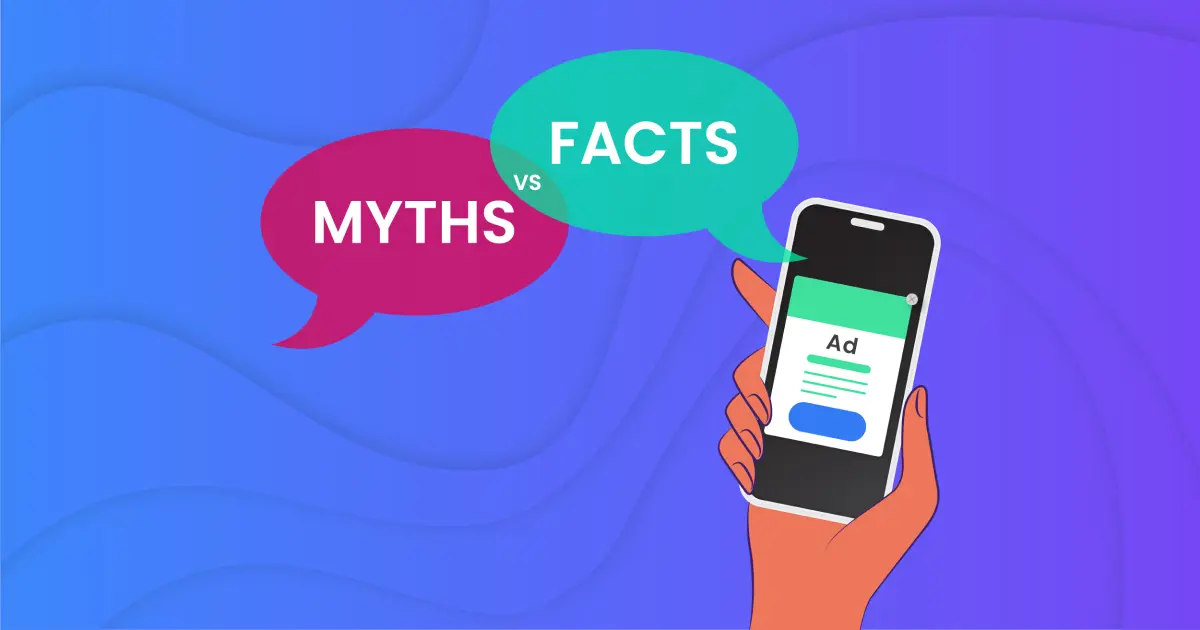The average user spends about 4 hours and 48 minutes per day on their smartphones, with 88% of this time within apps. Surprisingly, only 34 minutes (or 7.6% of time) is spent per day on Facebook and Instagram but these platforms take a disproportionate share of US digital ad spend (19.5%). So, if most users are spending most of their time using apps, why are so many performance marketers disproportionately allocating their ad budgets to walled gardens and overlooking other in-app channels?
Today, a significant portion of digital ad inventory across display, in-app, CTV, digital out of home (DOOH) and other channels, is transacted programmatically. Last year alone over 91% of $148 billion in digital display dollars were sold via programmatic buying. With the majority of in-app inventory bought and sold through RTB (real-time-bidding) auctions, it’s critical that performance marketers invest in partnerships and strategies that make this buying method work.
There are many misconceptions, about in-app advertising (IAA) and programmatic buying that continue to pervade the marketplace. But, the digital advertising ecosystem has evolved since the rise of in-app advertising in the 2000s and many of the reservations performance marketers have about in-app advertising are no longer valid or based on incorrect information.
In-app advertising misconceptions
Here are five common misconceptions about buying in-app ads programmatically that continue to deter advertisers from confidently investing their media budgets in-app.
Myth #1: In-app advertising only works for app install campaigns
Any brand can leverage in-app inventory via programmatic buying whether they have an app or not. In fact, we’ve helped many brands and agencies without their own apps scale their marketing spend via in-app advertising with conversion flows that direct new customers to web landing pages to undertake certain actions — like signing up for a free trial. This allows advertisers to connect with users where they spend the majority of their digital time – within apps – but still leverage their existing mobile landing pages and conversion flow.
Myth #2: Buying IAA programmatically only works for big brands with large budgets using a dCPM pricing model
The assumption that programmatic buying only works for big brands and budgets is wrong. Smaller advertisers with limited budgets can drive great value from programmatic advertising. We adjust our bids based on the predicted likelihood a user will take a desired action after seeing the ad. In other words, we increase / decrease our bids relative to which users are predicted to be more / less valuable to the advertiser which yields substantially higher ROAS for advertisers and maximizes the impact of a tight budget.
Myth #3: I won’t be able to find my target audience in-app
As mentioned above, the average user spends about 4 hours and 48 minutes per day on their smartphones, with 88% of this time within apps. This means the majority of customers can be found in-app. We see on average up to 200 billion bid requests a week and because of programmatic buying’s advanced targeting options, advertisers can more efficiently find their audience across the in-app ecosystem via hyper-targeted parameters.
Myth #4: I’m already paying for ads on the major social networks so there’s not much value for me to also invest in in-app channels
Currently, 34% of US consumers’ time is spent on Facebook, Google and Amazon but 60% of ad budgets are spent here. This shows a significant gap between ad dollars and consumer behavior — and a huge opportunity for marketers, agencies and brands to tap into a sizable and engaged audience outside of the walled gardens through in-app advertising.
As a performance marketer, the good news is you don’t have to choose one channel over the other. But it’s critical for marketers to consider all their options. They can no longer afford not to engage their audience where they are and will continue to be most active — in-app.
Myth #5: Programmatic lacks transparency and brand safety
While challenges with transparency and brand safety have existed in programmatic advertising, advancements in the field are addressing these issues head-on. Many programmatic platforms now offer advanced reporting features and integrations, allowing advertisers to have better visibility into where their ads are being displayed and how their budget is being allocated.
Moreover, brand safety tools and strategies, such as category blocking and the use of whitelists and blacklists, ensure ads appear in suitable contexts, protecting a brand’s image. There are also several ad verification companies that partner with programmatic platforms to provide additional layers of protection for advertisers, including monitoring ad placements and identifying potential brand safety risks in real-time.
In-app advertising is a necessity, not an option
Looking ahead at the trajectory of consumer digital behavior, the IAA market is poised to grow. In fact, research shows the global in-app advertising market is expected to reach $904.61 billion by 2032 at a CAGR of 20.87%. These projections indicate a robust and steady expansion of the in-app advertising market over the next decade.
Embracing in-app advertising via programmatic buying enables advertisers to reach highly engaged audiences and deliver personalized ad experiences at scale. As the digital advertising ecosystem evolves, the future of digital marketing is increasingly in-app, and programmatic is the key to unlocking it.
